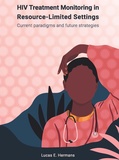HIV Treatment Monitoring in Resource-Limited Settings
Current Paradigms and Future Strategies

Hermans, Lucas
- Promoter:
- Prof.dr R.A. (Roel) Coutinho & prof.dr A.M.J. (Anne) Wensing
- Co-promoter:
- dr M. (Monique) Nijhuis
- Research group:
- Wensing Nijhuis
- Date:
- November 15, 2022
- Time:
- 12:15 h
Summary
This thesis is concerned with the clinical and scientific effort of ensuring durable effectiveness of ART through implementation of innovative and cost-effective ways to detect treatment failure in resource-limited settings. The research presented in this thesis was performed in South Africa, one of the most severely affected countries, but aims to be of relevance to the sub-Saharan African region as a whole. Part of this evidence was generated within the ITREMA randomised clinical trial (RCT), a multidisciplinary effort to perform clinical and translational research on treatment monitoring in resource-limited settings, led by various academic institutions in The Netherlands and South Africa.
The first part of this thesis (Chapters 2-8) evaluates current success rates of treatment, risk factors for adverse outcomes of ART and shortcomings of current ART monitoring algorithms. The role of these algorithms as barriers to the achievement of higher treatment success rates are also described.
Chapters 2 and 3 describe a collaborative research project in which we combined a large sample of public sector clinical record data with the national laboratory database in South Africa. This project aimed to study outcomes of ART in a large representative cohort of PLHIV in rural and urban South Africa. Chapter 2 provides a detailed report of current treatment success rates in this population. It also describes the outcomes of PLHIV who develop treatment failure and identifies some of the obstacles in appropriate management of treatment failure in clinical practice. Chapter 3 describes the impact of the lenient quantitative HIV-RNA (viral load) threshold of 1000 copies/mL that is maintained to define treatment failure by the World Health Organisation. Although this definition classifies PLHIV who have low-level detectable viral loads as being successfully treated, these individuals are in fact at increased risk of treatment failure.
In Chapters 4 and 5 we look beyond the medical realm and consider how various socio-economic and behavioural factors may shape outcomes of ART. Chapter 4 is a systematic review and meta-analysis examining the role that these factors play in predicting loss to follow-up from treatment programmes. In Chapter 5, data collected on participants in the ITREMA RCT was leveraged to study how socio-economic circumstances as well as behaviour and mental health relate to non-adherence and treatment failure.
Chapters 6, 7, and 8 report on viral genetic aspects of HIV and their impact on patient health and outcomes of ART. Chapter 6 is a systematic review and meta-analysis of the effect of pretreatment drug resistance of HIV on clinical outcomes, and Chapter 7 is a sub-analysis of pretreatment drug resistance in participants in the ITREMA RCT. Chapter 8 is a cross-sectional analysis of HIV co-receptor tropism in participants in the CoRecTSA study, and reports on clinical and immunological correlates of coreceptor tropism of HIV-1 subtype C prior to the start of ART.
The second part of this thesis (Chapters 9-12) aims to demonstrate that diagnostic tools can provide solutions to the current shortcomings of clinical management of treatment failure. We describe both the development as well as the implementation of these tools in clinical practice.
Chapter 9 describes the validation, and local implementation in rural South Africa of a qualitative drug exposure assay that can be used for the detection of various antiretroviral drugs in patient blood plasma in order to objectively assess patient adherence. Chapter 10 describes the primary outcome analysis of the ITREMA RCT, a single-centre open-label RCT of an intensified strategy for ART monitoring versus the standard of care in rural South Africa. This strategy consists of an escalating strategy of frequent viral load testing, followed by drug exposure testing using the assay described in Chapter 9 in case of an elevated viral load, followed by reflex drug resistance testing in case of a positive drug level test.
Chapters 11 and 12 describe novel applications for drug exposure testing in patients with virological failure. Chapter 11 is a retrospective study of South African adult patients on second-line ART with ritonavir-boosted lopinavir. The study describes how drug exposure testing can predict drug resistance to lopinavir in this population. Chapter 12 describes a secondary analysis of the ADVANCE RCT, in which a different approach to drug exposure, using a novel urine test for the detection of the antiretroviral metabolite tenofovir, was implemented to predict virological failure and drug resistance.
Chapter 13 reviews the evidence presented in this thesis and discusses its implications for future research and policy.